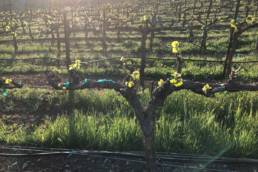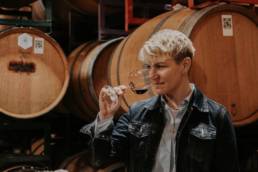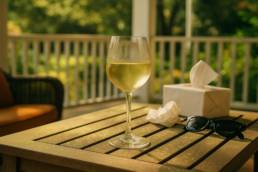FMN – September 2021 – “Natural” Wines
(American) Football has arrived and we are consumed with dreams of tailgating followed by the unrealistic expectations of our team winning it all. I’ll admit, I love an ice-cold beer while yelling expletive-laden jargon at my television but there is a place for wine in this game-time atmosphere as well. Remember, we are helping remove that foolish belief that wine is pretentious and only belongs with extravagant foods and at the swankiest of occasions.
The older I become, which beats the alternative, the more I realize that a little excess is justified (even if only in moderation). Sometimes you want what you want, without having to sacrifice. So, what I am attempting to convey is my desire to watch football, grill something that had parents and imbibe in copious amounts of wine consumption, without eliciting any compromise.
I’m a big fan of minimal intervention wines, meaning they are not over manipulated to make them into something we think they should be, rather than developing their own identity. Granted, this is a fine line the wine maker walks between minimalist ideology and bad (faulted) wine. That remains one reason why I was slightly skeptical about the non-interventionalist movement that unfortunately coined the consumer-misleading term “Natural Wine.”
Make no mistake, I think the wine industry fails miserably with disclosure of “non-natural” additions to their products. Any “movement” that calls attention to this fact and places pressure on producers to be more forthcoming about their, sometimes less than honorable practices, gets my vote. The issue remains that there has not yet been a good working definition of exactly what “natural” means in the milieu of wine production.
I’ve heard that to be considered a natural wine, the grapes must be grown organically, free from pesticide and herbicide use, and with little to no additives. That sounds reasonable and I certainly would prefer consuming these types of wines. The issues are twofold with this broad definition. Many producers have differing opinions on what additives are allowed.
Sulfur dioxide, for example, is the most widely used and most controversial additive in winemaking. Wines without the addition of sulfites are possible but they have a shorter shelf life and more easily succumb to bacterial contamination. A producer dedicated to this practice must be hyper diligent with their winemaking skills and cleanliness of equipment or face almost certain spoilage.
One side note about sulfites is that they are a natural byproduct to fermentation and therefore in all wines, be it sometimes in minute amounts. Thus, any marketing boasting a wine being “sulfite free” is a bit of a misleading statement. Sulfites also seem to get blamed as the cause for headaches that some associate with drinking wine. Although this could be the case, I think the argument loses credibility when those same people are able to consume dried fruit and french fries, both containing substantially higher levels of sulfites.
The second issue comes with some producers demonizing others, claiming that their wines are more natural compared to their competitors. This is an unusual situation as I have yet to hear one producer state that their wines were made more organically or more biodynamically than another producer’s wine. I enjoy those winemakers that are proclaimed “natural” or minimal interventionalists and simply state the mantra they follow for their production methods and let the consumer decide. You can make the most natural wine of any of your competitors, but if the palate resembles pond water that was run through a dirty garbage disposal, your level of “naturalness” becomes a moot point.
Perhaps the best practice would be to create definitions for these different certifications that the end consumer cannot only understand but feel better about what they put in their mouths. The terms organic, biodynamic and sustainable are all confusing to not only the person popping the cork but also those selling and pouring the juice. The marketing term “natural” needs some industry definition that will provide all of us with a better understanding of what we are (or are not) consuming.
As I stated previously, there are a tremendous amount of sketchy additives that sometimes make their way into some wines. We still fail to address the amount of “natural” (non-grape) things, that make it to the press. Technically known as MOG (material other than grapes), these cannot only be leaves and stems but also lizards, bugs and even baby birds; a reason why sorting is such an important step in the process. I’ve yet to hear an argument for the naturalness of these wine “additives”.
Although I sound a bit cheeky with my comments about natural wine, I think the movement will do quite a bit more good than harm. The benefits come from more transparency within the industry. This new disclosed information needs to be accompanied with consumer education so everyone can feel a bit more learnt about their consumption choices. The harm can only come from the increased latency of acquiring a proper defined standard as to what can be excluded (and more importantly included) in the production of these natural wines.
I wanted to demonstrate that you can enjoy some of these coined “natural wines”, and give up some of the additives without having to skimp on the quality of aromatics and flavor. Granted, some of these wines, no matter how you attempt to market them, are just faulted. With the best winemaking techniques, these minimal additive, low-intervention wines cannot only escape flaws but demonstrate to the consumer what exemplary wines may have tasted like generations ago.
So, as you are grilling your “free-range” chickens and “grass-fed” beef, why not wash them down with some juice that makes you feel better about what you put in your body. Or at least with some that are either grown organically, organically produced or maybe grown with sustainable viticulture (all said with my tongue in cheek).
Suggested Wines:
Domäne Wachau 2018 Ried Bruck Federspiel Riesling Wachau, Austria $24.99
This single vineyard in Wachau boasts extremely steep terraces and must be hand harvested. The Federspiel term dates back to medieval times, paying homage to the popular pastime of falconry. Wachau uses the terms Steinfeder, Federspiel and Smaragd to demonstrate increasing levels of ripeness at harvest, each with compulsory alcohol ranges.
This certified sustainable and vegan wine has a brilliant reflective golden color with aromas of smokey, flinty, mineral, with stone fruit skin (pear, apple), and kiwi. The palate is dry, with bright citric, brined linear acidity and a slightly more viscous body. Flavors of orchard fruit and tropical citrus (tangerine) fade to a brined (sea foam) mineral-laden finish. Pair with citrus marinated, grilled seafood (shrimp, swordfish), ceviche, fried calamari, or orange chicken.
Weingut Judith Beck Koreaa 2019 Burgenland, Austria $16.99
This Burgenland field blend of Grüner Veltliner, Scheurebe, Weissburgunder (Pinot Blanc), Neuburger, Welschriesling, and Zweigelt are grown biodynamically with minimal intervention, macerated and co-fermented in old oak barrels. The curious name “Koreaa” comes from the nickname adopted for this vineyard site in the 1950s (traditionally known as Fürstliches Prädium). With the artistry that Judith Beck uses to produce this low-intervention wine, and at only 800 cases, this wine is truly a unique treat.
One first notices the richer golden color that almost appears slightly oxidized but this comes from the few days maceration on the skin. The nose has layers of complexity with orchard fruit (pear, peach), citrus (clementine), spice (white pepper, ginger), hazelnut and a slight note of cheese curds (attributable to six months on the lees). The palate is bone dry with an interesting textured mouth-feel and a linear slightly citric mineral-laden acidity. The flavors mirror the palate with the tropical citrus more on the forefront. Pair this with grilled pork (sausages), stinky creamy cheeses and smoked trout.
2019 Heidi Schrock & Sohne Nostalgie Naturelle Vol. 2 Pet Nat Burgenland, Austria $27.99
The grapes in this 100% Pinot Blanc hail from vineyards in Rust, overlooking Lake Neusiedl. Using organic vineyard practices and adding no additional sulfur dioxide, Heidi Schröck produces this sparkling “Pet Nat” using the ancient Méthode Ancestrale. The fermentation continues in the bottle and the carbon dioxide dissolves into the wine, giving us some sparkle. The slightly cloudy nature is attributed to the expired yeast and in no way negatively affects the wine.
One notices the release of effervescence as the wine is poured into glass. The nose has the classic “autolytic” components (fresh baked yeast bread), orchard fruit (pear, apple) and citrus (tangerine, lemon). The palate is overtly dry with bright palate watering acidity and a fuller mouth-feel (due to mannoproteins from the yeast). The flavors mirror the palate with a lingering brined citrus finish. Pair with seafood po-boy sandwich, brie, or fried boudin balls.
Gabriёlskloof Syrah 2017 Bot River, South Africa $20.99
The Gabriёlskloof Estate rests between two mountain ranges; the Houwhoek range to the north and the Babylonstoren range to the south. With less than ten miles to the Atlantic coast, the vineyards enjoy the cooling affects from the Benguela current. This producer takes their impact on the environment seriously as evidenced by their status as a Biodiversity and Wine Champion.
One first notices the dark, brilliant, ruby color. The nose boasts complex overt aromas of blackberry, elderberry compote, sweet baking spice (allspice, nutmeg, and clove), unsweetened cocoa powder, and a haunting purple floral note (violet). The palate is dry with a broad viscous mouth-feel and palate warming alcohol. The tannins are integrating with a slight angular feel. This restrained Syrah could take a few years of bottle age or open now with north African influenced grilled lamb, well salted filet, or brisket.




